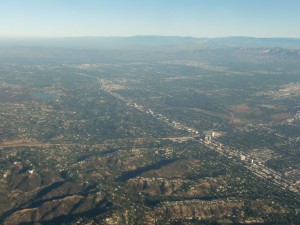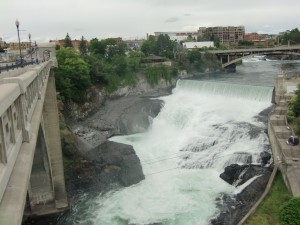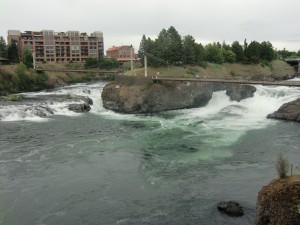EXPLORING THE ROCKIES – A BEGINNING AT SPOKANE
EXPLORING THE ROCKIES
This is the first in a series of articles about traveling in the Canadian Rockies
A BEGINNING AT SPOKANE
By Charles N. Stevens
Photos by Dolores Seidman
Our plane from Burbank flutters down through the gray overcast for a smooth landing at the Spokane Airport. We walk through the modern terminal where we meet our guide. As we have plenty of time, the tour bus takes us into downtown Spokane. The sky is rugged, but the temperature is quite pleasant.
We begin our walk at Park Square, first seeing the Spokane Falls located on the Spokane River that flows close to downtown. Leaning on a low concrete wall we look out at the magnificent falls. We are captivated by the roar of all that water cascading over rock shelves, the violent swirl of it, the white froth mixed with hints of turquoise. Both the upper falls and the lower falls are partially diverted into power plants for the generation of electricity. Although we didn’t do it, one can take rides on aerial gondolas that glide directly over the falls.
When tired of walking we sit in the park and watch kids splashing through a complex fountain, challenging the water, daring it to soak them. Fascinated with water like all kids, they enjoy getting wet. Squeaking seagulls wheel over the park and around a bright-colored carousel.
Back on the bus, we leave Spokane, a city that is much more widespread than we thought. Car dealers, malls and other stores are located far from the center of town. Outside of the city are green, grassy hills, the higher ones studded with pine trees. The more we rise in altitude, the thicker the forests, the tree rubbing shoulders with one another, their branches intermingling.
In short time we arrive at Coeur d’Alene, Idaho, a beautiful city situated on vast Coeur d’Alene Lake. Under a cloudy sky, the lake looks like a great silver platter. The lake feeds the Spokane River and is the source of the water tumbling over Spokane Falls. Eventually it flows into the Columbia River. Coeur d’Alene is popular with tourists, offering many hotels, parks, restaurants and sidewalk cafes as well as boating on the lake. Colorful petunias flow from pots on the city’s light standards, adding to the beauty. Float planes also use the lake, several of them parked near the docks.
I recall the good times we had in Coeur d’Alene many years ago when we visited friends there and spent some wild hours in a speed boat dashing across the lake and exploring its many tree-lined inlets and bays. We also discovered that it was a favorite retirement venue for the Los Angeles police.
Moving on past the city, we travel on Interstate 90 which borders the lake for many miles. Passing rain showers speckle the windshield of the bus.
We arrive at Kellogg, Idaho, a small place that once was a mining town. It is named after Noah Kellogg who discovered an outcropping of lead ore nearby. On the grounds of our hotel, the Guest House Inn and Suites, are some old pieces of mining equipment. The population of the town is just over 2,000 people, a far cry from the days when thousands more worked in the lead mines. The largest lead mine and smelter closed down in 1981, putting hundreds of people out of work. By the way, Noah is buried in the town cemetery.
From our hotel we can look up into the mountains where cables carry gondolas far up the slopes to 6,000 feet Silver Mountain, creating a wide bald streak that cuts through the dense forest. The gondolas pass just adjacent to our hotel .We look up at them suspended from the cables, inoperative and still, waiting for winter when it would become a ski resort. Kellogg has shifted from an active mining town to a famous ski resort.
Clouds still look lumpy and threatening as the day ends. We stroll around the grounds of the hotel in the twilight enjoying the scenery and the fresh air. Having risen very early to catch our plane, we’re ready for bed.

We leave Los Angeles (below) and head for Spokane, Washington.

The highlight of Spokane was the sight of Spokane Falls close to the center of the city.

Pictured here are the upper falls, which then lead to the lower ones.

A person can be immersed in the roar and the energetic beauty of the lower falls.
MONTEREY PARK AUTHOR PUBLISHES 4th BOOK – Seeking More of the Sky: Growing Up in the 1930’s:
Charles “Norm” Stevens, a 43 year resident of Monterey Park has recently published his 4th book: Seeking More of the Sky: Growing Up in the 1930’s. This is the story of a young boy growing up in Inglewood, California in the l930’s. This was a time during the depression when unemployment was affecting many and the banks were closed, while the clouds of war were gathering in Europe. But he was lucky enough to be raised in a loving family, the power of that love reflected throughout his stories.
Stevens is the author of three previous books about his experiences during WWII:
An Innocent at Polebrook: A Memoir of an 8th Air Force Bombardier (Story of his 34 bombing missions from his base at Polebrook, England over Germany and France)
The Innocent Cadet: Becoming A World War II Bombardier (A prequel to the first, telling of his training in the U.S. before going overseas into combat.)
Back from Combat: A WWII Bombardier Faces His Military Future from Combat: (This book details the time from when he returned from combat in England until the end of the war.)
He is known to the readers of The Citizen’s Voice as the author of Travel Log Articles including “Cruising the Rhine and Mosel”,” Best of the West”, “In Search of Snow” , “From Paris to Normandy on the Seine”, and “Exploring New York”. He is retired, having taught for 32 years, primarily in the Montebello Unified School District.
Those interested in purchasing an autographed copy of any of his books, may contact the author at 323-721-8230 or Normstevens24@gmail.com.



